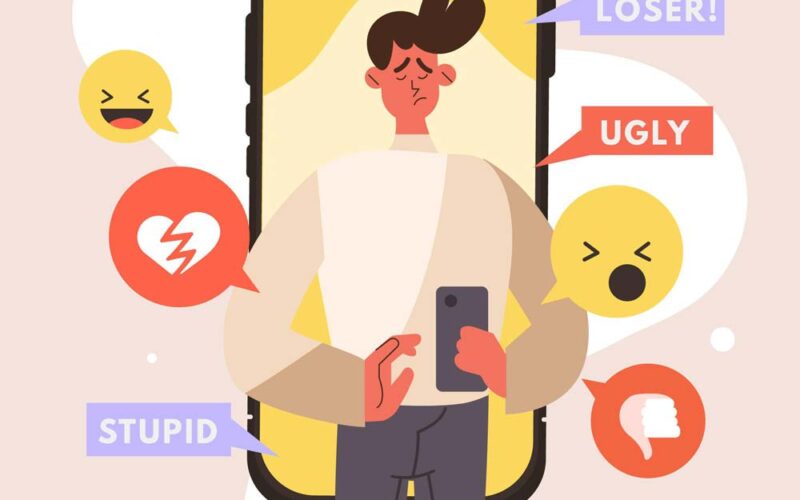1. What is bullying?
Bullying refers to the purposeful, repeated, or persistent exercise of power in interpersonal relationships via the continuation of physical, verbal, and/or social acts with the intention of directly causing bodily, psychological, or social harm. Because they misuse their confidence or influence, one or more people or groups that don’t care or don’t want to care may be involved in this violence.
Bullying can be done either indirectly, directly online, or offline. Violence is increasing through numerous digital platforms. It can occur either directly (obviously) or indirectly (secretly). Bullying doesn’t end just because time passes; it’s likely to repeat itself over time (National Centre Against Bullying, 2019).
2. What is cyberbullying?
Cyberbullying is using digital technology, or online platforms, to inflict harm. This can happen anywhere you can talk to the other person on social media, messengers, game platforms, and mobile phones. This is a repetitive action to inflict trauma or shame on the victim by the perpetrator himself on the targeted victims.
It is the act of spreading rumors about photos or videos without the victim’s consent on SNS. It is the act of sending threatening messages, images, and videos that hurt or insult victims through SNS.
Cyberbullying can sometimes happen concurrently through direct and indirect means. If there is a distinction between face-to-face and cyberbullying, it is that the former is less likely to leave digital proof in the form of digital footprints than the latter. It is able to be abandoned. According to UNICEF (2023), this is a highly practical and valuable record to end the violence.
3. Causes of bullying
1) The perpetrator has also been bullied.
Many of the offenders may have been bullied by friends or relatives in the past. The bullies from the past could have been bullied so badly that they feel worthless and believe that a great deal of resentment builds up and that they deserve to experience the same things that they have.
Because the horrifying recollection of the violent incident cannot be forgotten, it may have come to be thought of as bullying, particularly if it happened when the victim was a small child and still developing (Gould, 2022b).
2) The perpetrator suffers from low self-esteem.
You should give yourself self-confidence and self-worth if you believe that you are not more intelligent than others are, that you are unworthy, or otherwise feel that you have no value. The perpetrators of these acts obtain their confidence and self-esteem by undermining the confidence and self-worth of others, which they believe to be the simplest and quickest way to do so. However, offenders will quickly realize that this is a losing tactic since the victim could fight back. Regretfully, nevertheless, the offenders will most likely locate someone they perceive to be weak and do the same crime again (Gould, 2022b).
3) The perpetrator has a lack of social skills.
To put the lack of social skills under the theme of jealousy and timing, jealousy is a feeling that you don’t want to be deprived of what you have, and timing is a negative feeling that you want to have what you don’t have. Even if they feel this way about the other person, most individuals don’t want to do something that may hurt them. However, the offenders—who are socially awkward—are not like this. One of the reasons the offender annoys the victim is that they don’t see what the other person has that they don’t have. The victim will most likely feel envious. This may also be related to the reason for the offender’s poor confidence and sense of self-worth. As a result, the offender will communicate their displeasure to the victim, the target, if they are envious of that person (Gould, 2022b).
4. The difference between bullying and cyberbullying
- Cyberbullying
Initially, it might happen through messaging apps on smartphones and the Internet. Cyberbullying is the term for this type of bullying, which is more difficult for outsiders to learn about or identify than traditional bullying. The reason is that because the perpetrators of cyberbullying may more easily pose as someone else, it becomes more difficult to identify them. Cyberbullying is a pattern of verbally abusive behavior that is most likely to happen online. The bully is generally merciless and lurks in the shadows. He intimidates his targets and does so for an extended period of time (Smith, 2023).
- In-person bullying
Face-to-face bullying is characterized by the attacker abusing the victim verbally, emotionally, and/or physically. While face-to-face bullying can happen anywhere in the real world, cyberbullying can happen anytime. Unlike cyberbullying, face-to-face harassment cannot be concealed by anonymity, making it easier to stop. On the other hand, face-to-face bullying has the drawback of not leaving as much proof as cyberbullying, despite the fact that cyberbullying may readily leave a digital trail (Smith, 2023).
Gould, W.R. (2022). 7 Common Reasons Why People Bully. [online] Verywell Mind. Available at: https://www.verywellmind.com/common-reasons-why-people-bully-5496259 [Accessed 11 November. 2023].
National Centre Against Bullying (2019). Definition Of Bullying | National Centre Against Bullying. [online] Ncab.org.au. Available at: https://www.ncab.org.au/bullying-advice/bullying-for-parents/definition-of-bullying/ [Accessed 11 November 2023].
Smith, E. (2023). Difference Between Bullying and Cyber Bullying (With Table) – Ask Any Difference. [online] askanydifference.com. Available at: https://askanydifference.com/difference-between-bullying-and-cyber-bullying/ [Accessed 11 November 2023].
UNICEF (2023). Cyberbullying: What is it and how to stop it | UNICEF. [online] www.unicef.org. Available at: https://www.unicef.org/end-violence/how-to-stop-cyberbullying#:~:text= [Accessed 11 November 2023].
